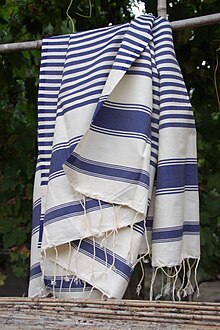| This article needs additional citations for verification. Please help improve this article by adding citations to reliable sources. Unsourced material may be challenged and removed. Find sources: "Peshtemal" – news · newspapers · books · scholar · JSTOR (January 2021) (Learn how and when to remove this message) |

A peshtemal (also spelled peshtamal, pestamal, pestmal, or pestema ; from Persian~ Fa puştmāl پشتمال back towel § Fa puşt پشت back + Fa māl مال cleaning) is a traditional towel used in baths. A staple of Persian , Persian peshtemal had a strong influence on Ottoman culture, dating back hundreds of years, the pestemal was originally designed to help individual bathers maintain their privacy. In addition to being highly absorbent, pestemals dry faster than thicker towels.
Traditionally, Persian has a red color with simple designs or shapes with black or white lines, but other colors and patterns are also common.
It is also used to indicate which region people are from. There are many kinds of peshtemal, with different styles and colors in different areas of Turkey and Iran.
The peshtemal absorbs water as fast as a terrycloth towel, dries more quickly, takes up less space, is easy to carry and is therefore used as an alternative in bathrooms, pools, spas, beaches, sports facilities, and for baby care.
The peshtemal fabric is made of 100% cotton produced on manually operated looms in modern Turkey, historically in Antioch.
See also
References
- "peştamal". Nişanyan Sözlük.
You can help expand this article with text translated from the corresponding article in Turkish. (February 2021) Click for important translation instructions.
|